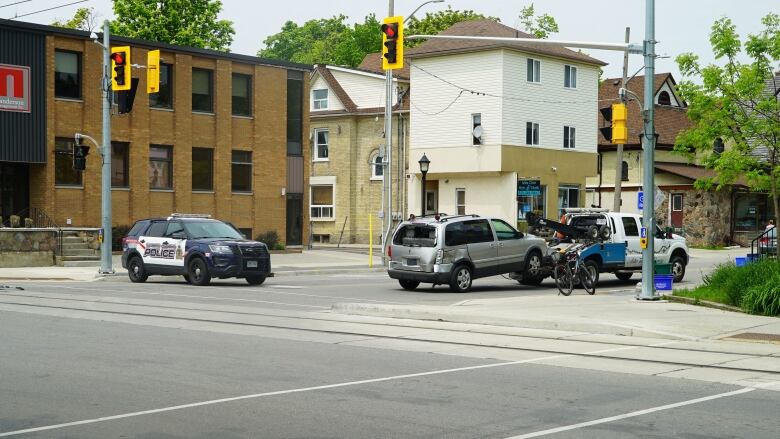$30K in damage to LRT vehicle after collision with van
Van driver charged with two offences, including failing to stop at a red light

The first accident between a vehicle and an LRT train will costapproximately $30,000 to fix.
Officers were called to the intersection of Duke Street W.,and Water Street N., in Kitchener at around 12:35 p.m. on Friday after a van collided with an LRT train.
Police said there were four people in the van, two of which sustained minor injuries and were taken to hospital as a precaution. The LRT driver wasnot injured.
The driver of the van is facing two charges, including failing to stop for a red light.
Protocols in place
Brandon Simon, senior project manager with the Region of Waterloo, told CBC Kitchener-Waterloothere are a number of different procedures and protocols in place for when an LRT vehicle is involved in a collision between a car, pedestrian or cyclist.
The LRT operator notifies the control centre, and the control centre then notifies the different agencies and emergency services that needto respond, Simon said.
Depending on the severity of the collision, it may cause a disruption in service, he added. If that's the case,ashuttle buswould be integrated to continueservice, and other LRT trains not affectedby the location of accident would continue to operate.
There are also procedures in place for when a vehicle gets stuck under a train crossing arm.
Simon said if the vehicle is not in the train's direct path, the LRT vehicle will proceed on a "caution basis,"which includesturning onflashers, sounding the horn and making sure the area is clear and safe to pass through.
If the vehicle is caught on the tracks, additional assistance will be called to clear the area, Simon adds.
This driver might not have had a gate come down on their car if they didn't drift forward while on their phone. pic.twitter.com/ZfL5CztcnR
—@danbrotherstonDrivers most likely at fault
Generally, if someone gets into an accident with an LRT vehicle, they will most likely be at fault, said Albert Schmidt, marketing manager and partner withErb and ErbInsurance Broker and Lackner McLennan Insurance in Kitchener.
"Because the LRT has right of way, if there's an accident, typically the driver of the vehicleinvolved will be deemed at fault and likely be charged as we've seen in this latest [collision]," he told CBC K-W.
In January 2017, the Regionof Waterloo added a new bylaw that states drivers are not allowed to park or stop on LRT tracks.
Schmidt said at-fault collisionsgenerally go on someone's record, which could alter insurance rates.
He adds drivers can talk to their insurance providers to see if they are eligible for "accident protection,"which won't alter insurance rates if it's a driver's first at fault collision.












_(720p).jpg)


 OFFICIAL HD MUSIC VIDEO.jpg)
.jpg)



























































































